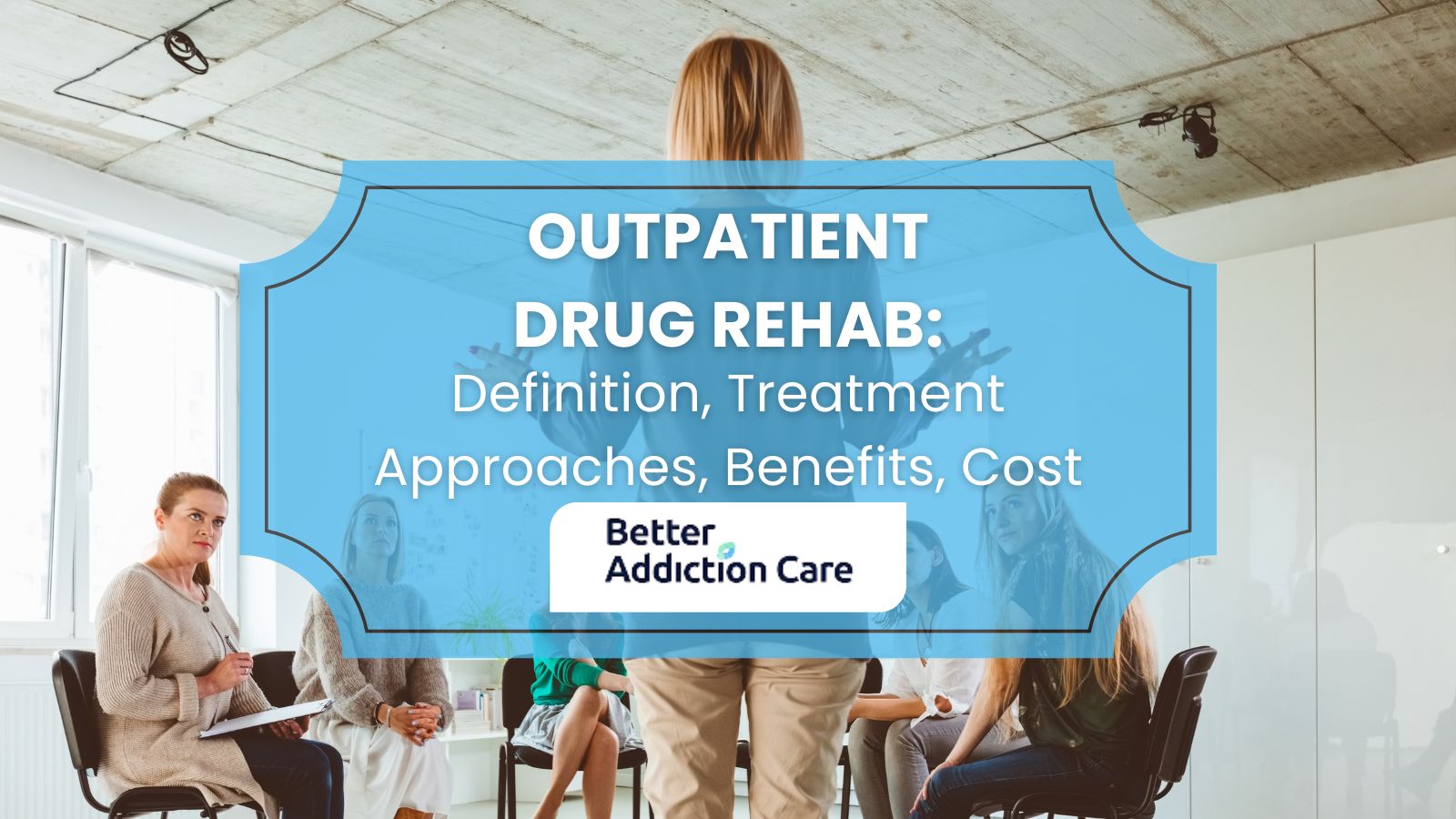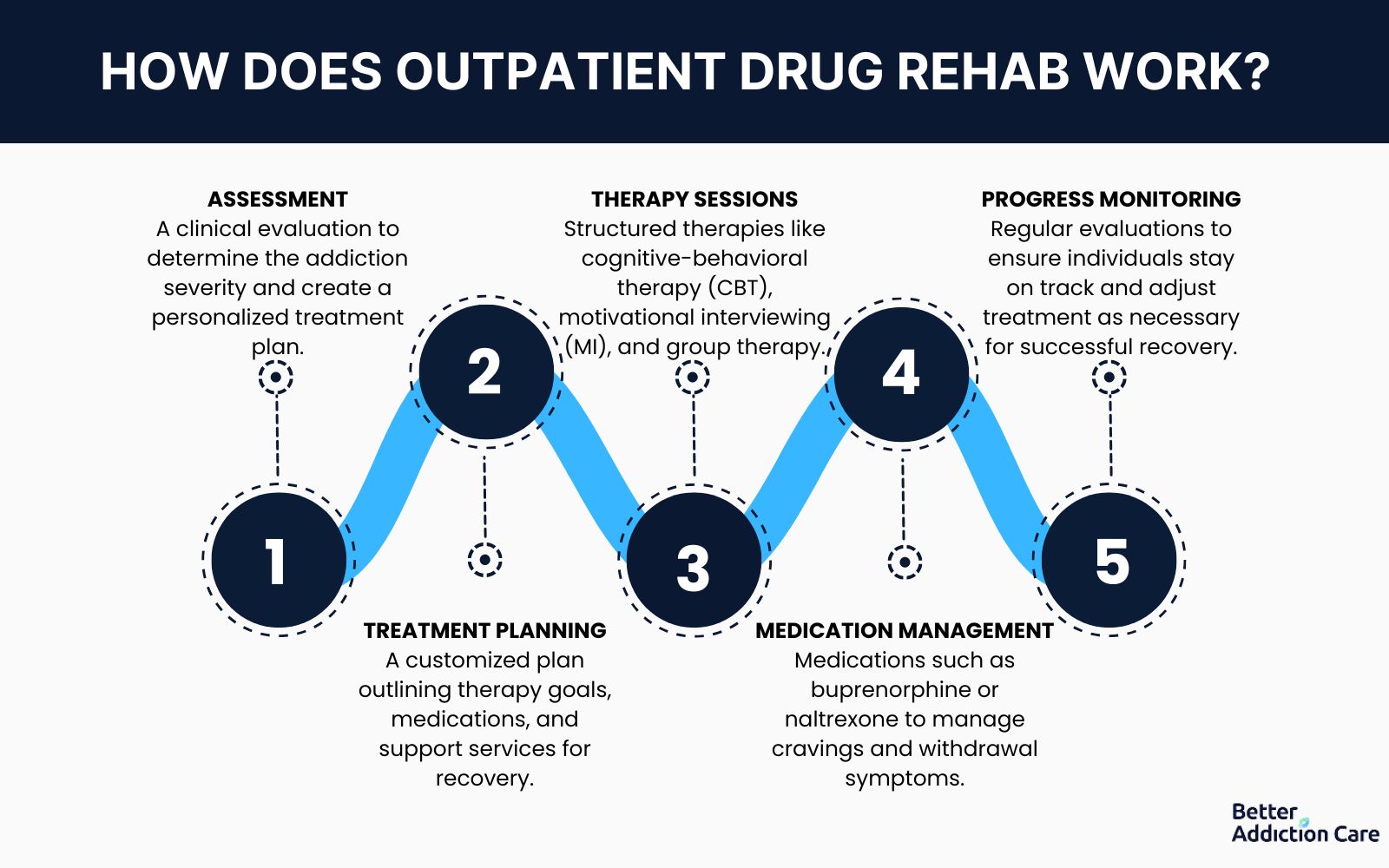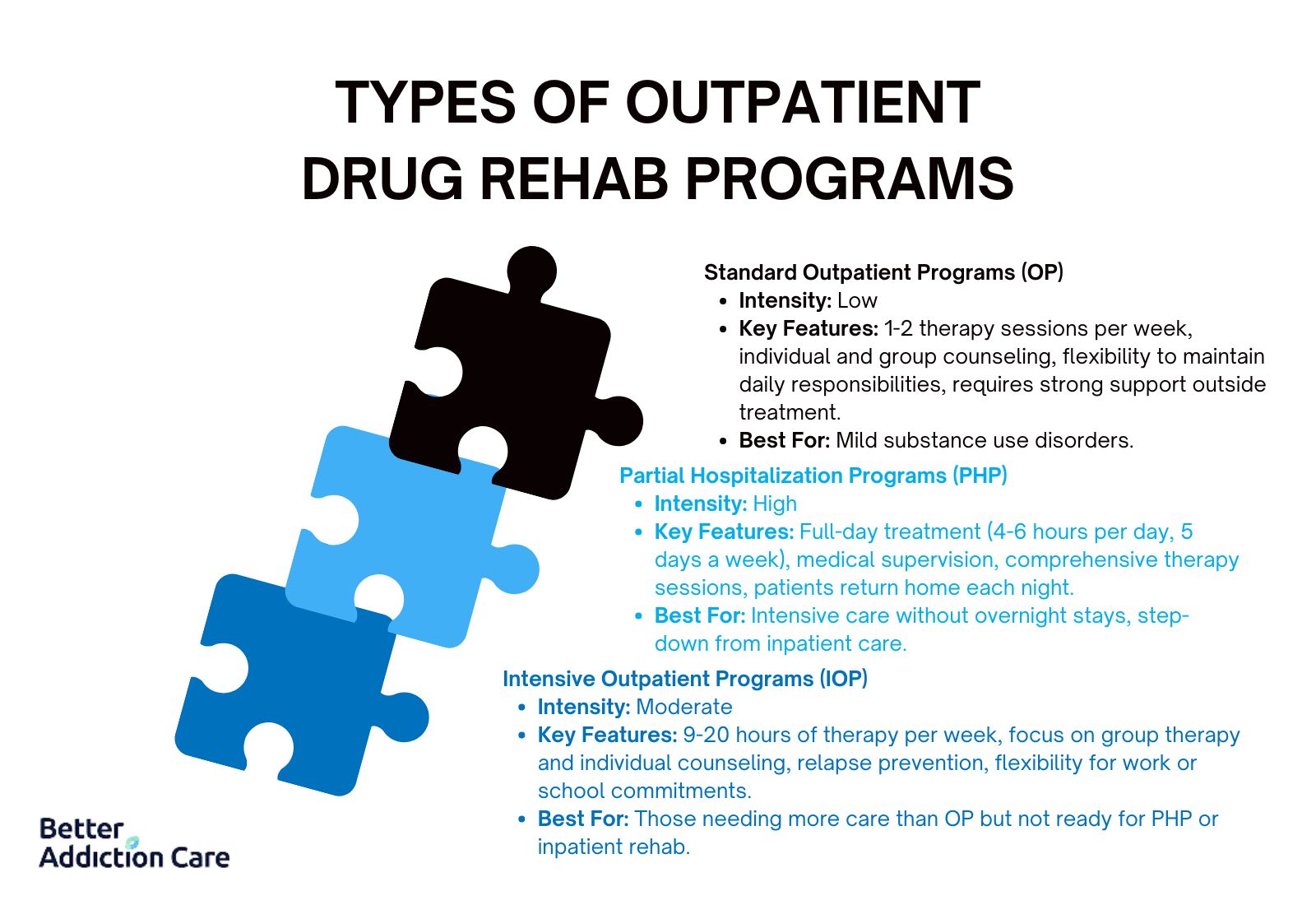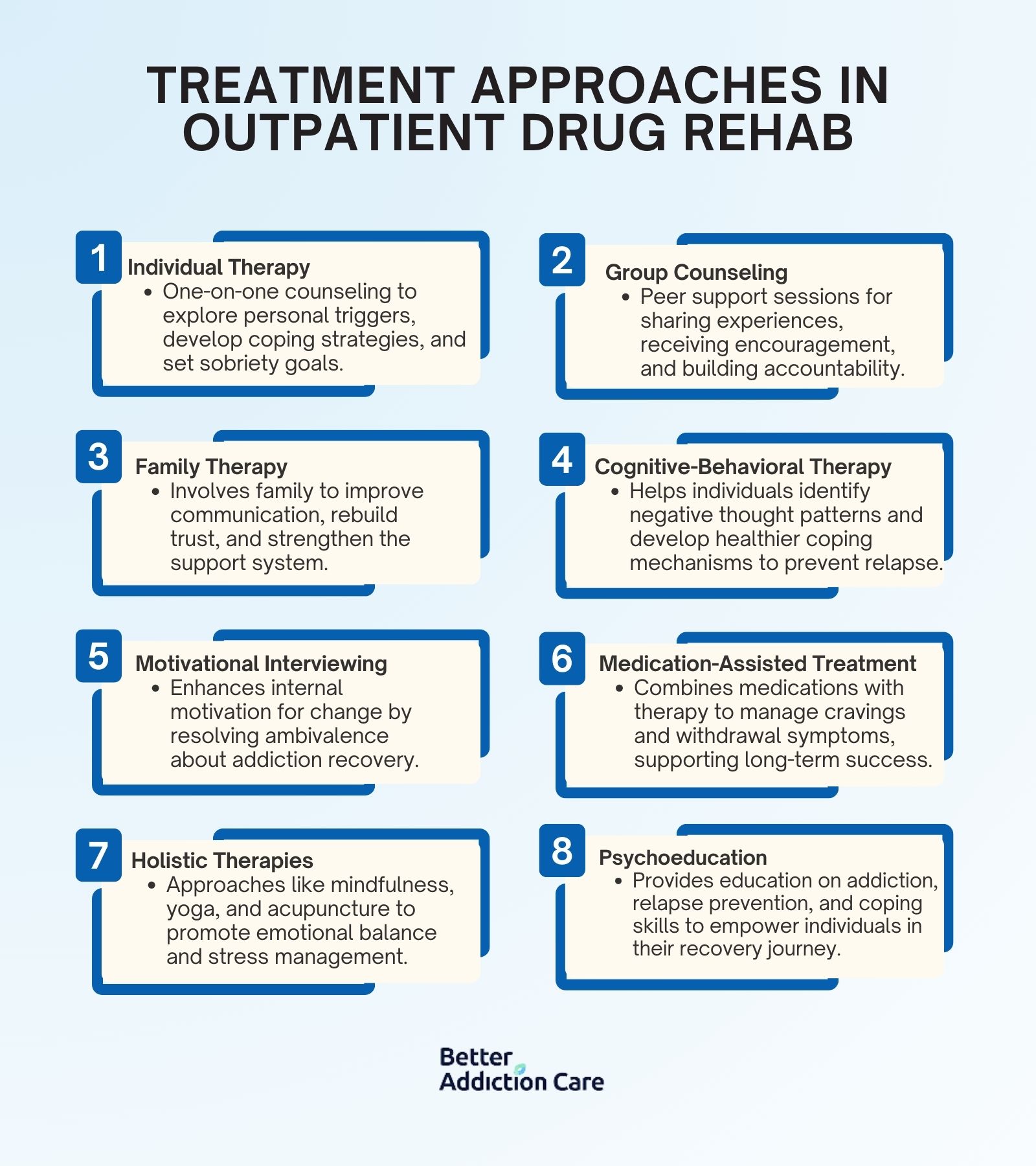Outpatient Alcohol Rehab: Definition, Treatment Approaches, Benefits, Cost
Outpatient alcohol rehab provides structured treatment for alcohol addiction while allowing individuals to live at home. This approach is important in recovery because it offers flexibility for people with work, family, or school commitments while still providing essential therapy and support. Many individuals seeking alcohol withdrawal treatment experience varying levels of withdrawal symptoms, making outpatient detoxification a viable option for those with mild to moderate symptoms. As noted by Meyer & Stohler (2005) in the study "Indications and Contraindications for an Alcohol Withdrawal Treatment of Outpatients," a significant percentage of individuals undergoing outpatient alcohol detox successfully complete the program without severe complications.

Outpatient alcohol rehab provides structured treatment for alcohol addiction while allowing individuals to live at home. This approach is important in recovery because it offers flexibility for people with work, family, or school commitments while still providing essential therapy and support. Many individuals seeking alcohol withdrawal treatment experience varying levels of withdrawal symptoms, making outpatient detoxification a viable option for those with mild to moderate symptoms. As noted by Meyer & Stohler (2005) in the study "Indications and Contraindications for an Alcohol Withdrawal Treatment of Outpatients," a significant percentage of individuals undergoing outpatient alcohol detox successfully complete the program without severe complications.
The typical process of outpatient alcohol rehab includes an initial assessment, personalized treatment planning, therapy sessions, and progress monitoring. Individuals attend scheduled sessions multiple times per week, which include group therapy, individual counseling, and educational workshops.
The major treatment approaches in outpatient alcohol rehab include cognitive-behavioral therapy (CBT), motivational interviewing (MI), and medication-assisted treatment (MAT). CBT helps individuals change negative thought patterns, MI strengthens motivation for sobriety, and MAT uses medications like naltrexone to reduce cravings and prevent relapse.
The key benefits of outpatient alcohol rehab include affordability, flexibility, and access to professional support. Outpatient care costs significantly less than inpatient treatment, allows individuals to maintain daily responsibilities and provides ongoing therapy to reinforce long-term recovery.
The average cost of outpatient alcohol rehab in the U.S. ranges from $1,400 to $10,000 for a three-month program. Costs vary based on location, treatment intensity, and insurance coverage, making it a more accessible option for many seeking recovery.
What Is Outpatient Drug Rehab?
Outpatient drug rehab is a structured treatment program that provides flexible, part-time care for individuals struggling with addiction while allowing them to continue their daily responsibilities while living at home. The core purpose of outpatient drug rehab is to support recovery through therapy, counseling, and medication management without requiring a residential stay.
Outpatient programs help patients transition from hospitalization to ongoing treatment by offering scheduled therapy sessions, medical support, and relapse prevention strategies. Over 26 weeks, the Boston Medical Center Addiction Consult Service completed 337 addiction consultations, linking patients to structured outpatient care for substance use disorders, with 76% of those on methadone successfully transitioning to a clinic as noted by Trowbridge et al. (2017) in the study "Addiction Consultation Services - Linking Hospitalized Patients to Outpatient Addiction Treatment."
How Does Outpatient Drug Rehab Work?
Outpatient drug rehab works by following a process that includes assessment, treatment planning, therapy sessions, and progress monitoring. This approach allows individuals to receive addiction care while maintaining their daily responsibilities.

The steps for outpatient drug rehab are listed below:
-
Assessment – A clinical evaluation determines the severity of addiction and the appropriate level of care. Medical and psychological assessments help create a personalized treatment plan.
-
Treatment Planning – A customized plan outlines therapy goals, medications, and support services to guide the individual through recovery.
-
Therapy Sessions – Structured sessions include cognitive-behavioral therapy (CBT), motivational interviewing (MI), and group therapy to address triggers and coping skills.
-
Medication Management – Medications like buprenorphine or naltrexone is prescribed to manage cravings and withdrawal symptoms.
-
Progress Monitoring – Regular evaluations ensure individuals stay on track, adjusting treatment plans as needed for continued success in recovery.
How Does Outpatient Drug Rehab Compare to Inpatient Drug Rehab?
Outpatient drug rehab compares to inpatient drug rehab by providing addiction treatment without requiring a residential stay. Outpatient drug rehab is more flexible, allowing individuals to continue work or school, while inpatient drug rehab requires a full-time commitment in a controlled environment. Outpatient care successfully transitions individuals into structured addiction treatment, with 76% of methadone patients linking to clinics as noted by Trowbridge et al. (2017) in the study "Addiction Consultation Services - Linking Hospitalized Patients to Outpatient Addiction Treatment."
|
Aspect |
Outpatient Drug Rehab |
Inpatient Drug Rehab |
|
Living Arrangements |
Stay at home |
Live in a treatment facility |
|
Flexibility |
Flexible schedule, part-time commitment |
Full-time, 24/7 care |
|
Cost |
Lower cost due to no residential fees |
Higher costs for housing and intensive care |
|
Support Structure |
Structured therapy sessions |
24/7 medical and psychological support |
|
Best For |
Mild to moderate addiction |
Severe addiction or high relapse risk |
What Level of Commitment Is Required for Outpatient Drug Rehab to Be Effective?
The level of commitment required for outpatient drug rehab to be effective includes consistent attendance, personal dedication, and significant lifestyle changes to support long-term recovery. Patients must attend therapy sessions multiple times per week, with intensive outpatient programs requiring nine or more hours of treatment weekly. Personal dedication involves actively engaging in counseling, completing assigned recovery tasks, and applying coping strategies outside of treatment sessions. Making lifestyle changes such as avoiding triggers, adopting healthier routines, and building a strong support network significantly improves recovery outcomes in structured outpatient settings.
How Long Does an Outpatient Drug Rehab Program Typically Last?
An outpatient drug rehab program lasts between 30 to 90 days, though some programs extend up to six months or more based on individual needs. According to the Substance Abuse and Mental Health Services Administration (SAMHSA, 2022), 30-day programs focus on short-term stabilization, while 60- and 90-day programs provide deeper behavioral therapy and relapse prevention support. The duration varies depending on the severity of substance use disorder, progress in therapy, and personal commitment to recovery, with some individuals requiring long-term outpatient care for sustained sobriety.
What Is the Aftercare Once Completing Outpatient Drug Rehab?
The aftercare once completing outpatient drug rehab includes relapse prevention programs, sober living homes, continued counseling, and support groups to maintain long-term recovery. These aftercare options provide ongoing support and structure to help individuals stay sober after formal treatment ends. Many individuals benefit from continued relapse prevention support, as 76% of methadone patients successfully transitioned to outpatient care following hospitalization, as noted by Trowbridge et al. (2017) in the study "Addiction Consultation Services - Linking Hospitalized Patients to Outpatient Addiction Treatment."
The key aftercare options for relapse prevention are listed below:
-
Relapse Prevention Programs – Structured plans teach coping skills, identify triggers, and provide strategies to prevent relapse. Regular check-ins with counselors and participation in therapy sessions strengthen long-term recovery.
-
Sober Living Homes – Drug-free housing offers a structured environment for individuals transitioning from outpatient care. Residents follow house rules, attend meetings, and build supportive relationships to reinforce sobriety.
-
Continued Counseling – Ongoing therapy sessions help individuals address underlying mental health issues, manage stress, and develop healthy habits that support long-term recovery.
-
Support Groups – Peer-led meetings like Alcoholics Anonymous (AA) and Narcotics Anonymous (NA) provide accountability, encouragement, and a sense of community for individuals working to maintain sobriety.
What Are the Different Types of Outpatient Drug Rehab Programs?
The different types of outpatient drug rehab programs include standard outpatient programs (OP), partial hospitalization programs (PHP), and intensive outpatient programs (IOP), each offering varying levels of care. Outpatient treatment is widely used, with 82% of treatment facilities in the U.S. providing some form of outpatient care. Specifically, 76% of facilities offer OP, 45% offer IOP, and 14% offer PHP, as noted by the Substance Abuse and Mental Health Services Administration (SAMHSA) in the 2020 National Survey of Substance Abuse Treatment Services.

Standard Outpatient Programs
Standard Outpatient Programs (OP) are the least intensive form of addiction treatment, suitable for individuals with mild substance use disorders who require minimal supervision. These low-intensity programs focus on self-management and typically involve:
-
1-2 therapy sessions per week – Individuals attend scheduled therapy sessions while continuing daily activities.
-
Individual counseling and group therapy – Treatment includes one-on-one counseling and peer support groups.
-
Flexibility to maintain daily responsibilities – OP allows individuals to work, attend school, or care for the family.
-
Requirement for a strong support system outside of treatment – Success depends on personal commitment and external support.
Partial Hospitalization Programs (PHP)
Partial Hospitalization Programs (PHP) provide structured therapy and intensive care without overnight stays. These programs offer:
-
Full-day treatment (4-6 hours per day, 5 days a week): Patients participate in comprehensive therapy sessions during the day.
-
Medical supervision and monitoring: Doctors and nurses oversee withdrawal symptoms and medication use.
-
Comprehensive therapy sessions: PHPs include behavioral counseling, structured therapy, and group support.
-
Behavioral counseling: Patients learn coping mechanisms and develop healthier thought patterns.
-
Ability to return home each night: Unlike inpatient rehab, PHP patients do not stay at the facility overnight.
-
Intensive support for those transitioning from inpatient care: PHP is a step-down from residential treatment.
Intensive Outpatient Programs (IOP)
Intensive Outpatient Programs (IOP) offer a middle ground between OP and PHP, providing structured treatment with more flexibility. Key features include:
-
9-20 hours of therapy per week: More intensive than OP but requiring less time than PHP.
-
Focus on group therapy and individual counseling: Patients receive structured support for addiction recovery.
-
Skill-building for relapse prevention: Therapy emphasizes coping strategies and behavioral adjustments.
-
Flexibility to maintain work or school commitments: IOP allows individuals to balance treatment with daily life.
-
Suitable for those needing a higher level of care than OP but unable to commit to PHP or inpatient rehab: IOP bridges the gap between lower and higher levels of care.
Intensive outpatient programs serve a significant portion of those in addiction treatment, with IOPs treating approximately 12% of the 1.2 million patients in specialty addiction care, as noted by McCarty et al. (2014) in a study published in Psychiatric Services.
Can You Do Outpatient Drug Rehab Online or via Telehealth?
Yes, you can do outpatient drug rehab online or via telehealth through virtual treatment programs that provide therapy, counseling, and medical support in a remote setting. Online outpatient rehab offers individual and group therapy sessions through video calls, secure messaging, and digital treatment platforms, allowing individuals to receive structured care without visiting a facility. Virtual addiction treatment includes cognitive-behavioral therapy (CBT), relapse prevention planning, and medication management, making it accessible for those with scheduling conflicts or limited transportation.
Do Outpatient Drug Rehabs Include Medically Assisted Treatment (MAT)?
Yes, Outpatient drug rehabs do include medically assisted treatment (MAT) because it helps manage withdrawal symptoms and reduces relapse risk. MAT combines FDA-approved medications like buprenorphine, methadone, or naltrexone with therapy to support long-term recovery. Patients receiving MAT in outpatient settings have improved treatment retention and reduced opioid use compared to those in therapy alone, according to SAMHSA in the National Survey of Substance Abuse Treatment Services (2020).
What Treatment Approaches Are Used in Outpatient Drug Rehab?
The treatment approaches used in outpatient drug rehab focus on behavioral, medical, and holistic therapies to support long-term recovery. Outpatient rehab integrates these substance abuse treatments, with MAT improving patient retention and relapse prevention outcomes, as noted by SAMHSA in the National Survey of Substance Abuse Treatment Services (2020).

The treatments are listed below:
-
Individual Therapy: One-on-one counseling helps patients explore personal triggers, develop coping strategies, and set goals for sobriety. Therapists use evidence-based techniques tailored to individual needs.
-
Group Counseling: Peer support sessions provide a space to share experiences, receive encouragement, and build accountability within a structured setting.
-
Family Therapy: Family involvement improves communication, rebuilds trust, and strengthens the support system critical for sustained recovery.
-
Cognitive-Behavioral Therapy (CBT): CBT helps individuals recognize negative thought patterns and develop healthier coping mechanisms to prevent relapse. According to Kaczkurkin & Foa (2022) in "Cognitive-Behavioral Therapy for Anxiety Disorders: An Update on the Empirical Evidence," CBT reduces substance use disorder symptoms by 60–80% and helps patients maintain recovery.
-
Motivational Interviewing: This approach enhances internal motivation for change by helping patients resolve ambivalence about overcoming addiction.
-
Medication-Assisted Treatment (MAT): MAT combines medications with therapy to manage cravings and withdrawal, increasing the likelihood of long-term success. According to Maiti et al. (2020) in "An Overview on Medication-Assisted Treatment (MAT) for Opioid Dependence," MAT decreases opioid overdose deaths by 59% and improves treatment adherence rates by 66%.
-
Holistic Therapies: Alternative approaches like mindfulness, yoga, and acupuncture promote emotional balance and stress management alongside traditional treatment.
-
Psychoeducation: Educational sessions provide insight into addiction, relapse prevention, and coping skills, empowering individuals to take control of their recovery.
Does Outpatient Drug Rehab Administer Drug Tests?
Yes, outpatient drug rehab does administer drug tests to monitor sobriety and ensure treatment effectiveness. Drug tests help assess progress and detect potential relapse, allowing for timely intervention. Facilities commonly use urine tests to screen for substances, while blood alcohol content (BAC) tests measure alcohol levels in patients undergoing treatment for alcohol addiction. Regular testing holds individuals accountable and helps tailor treatment plans to support long-term recovery.
What Are the Benefits of Outpatient Drug Rehab?
The benefits of outpatient drug rehab provide essential support while allowing individuals to continue daily responsibilities, as outlined below:
-
Flexibility: Patients attend therapy sessions while maintaining work, school, and family obligations. Scheduled treatment allows for structured support without full-time residential care.
-
Affordability: Outpatient programs cost significantly less than inpatient rehab because they do not include housing or 24/7 supervision. Many insurance plans cover outpatient services, making treatment more accessible.
-
Ability to maintain daily life: Patients live at home and integrate newly learned coping strategies into real-world environments. This approach fosters independence while receiving professional support.
-
Access to family support: Staying connected with family members provides emotional encouragement and stability. Family involvement in therapy helps repair relationships and strengthens the individual’s support network.
What Are the Limitations of Outpatient Drug Rehab?
The limitations of outpatient drug rehab include the lack of 24/7 medical supervision, the need for a stable home environment, and lower success rates for severe addictions. Outpatient programs do not provide round-the-clock care, making them unsuitable for individuals experiencing intense withdrawal symptoms or frequent relapses. The effectiveness of treatment depends on personal commitment and external support, which limit recovery outcomes for those without strong family or community backing. Individuals with severe substance use disorders require inpatient rehab for structured care and medical monitoring to ensure long-term success.
How Much Does Outpatient Drug Rehab Cost in the U.S.?
Outpatient drug rehab costs in the U.S. range from $1,400 to $10,000 for a 30-day program, with some intensive programs costing $10,000 to $30,000 over several months. The price varies based on treatment intensity, facility location, and additional services such as medication-assisted treatment (MAT) or specialized therapy. Insurance coverage, financial aid, and sliding-scale payment options help reduce costs for those seeking treatment.
Is Outpatient Drug Rehab Covered by Insurance?
Yes, outpatient drug rehab is covered by insurance, including private insurance, Medicaid, and Medicare, under the Affordable Care Act (ACA). The ACA requires insurance providers to cover substance use treatment as an essential health benefit, making outpatient rehab more accessible. Coverage levels depend on the plan, with some policies covering full treatment costs while others require copayments or deductibles, as noted by the Affordable Care Act (2010) in the Patient Protection and Affordable Care Act legislation.
What Is the Success Rate of Outpatient Rehab in the U.S.?
The success rate of outpatient rehab in the U.S. varies, with studies showing that 40% to 60% of individuals maintain long-term sobriety after treatment, according to the National Institute on Drug Abuse (NIDA). Success depends on several factors, including therapy engagement, medication adherence, and a strong support system. Individuals who participate in relapse prevention programs and continue counseling after treatment have higher success rates. Structured outpatient programs that combine medication-assisted treatment (MAT) and behavioral therapy significantly improve outcomes for individuals recovering from addiction.
Who Are Ideal Candidates for Outpatient Drug Rehab?
Ideal candidates for outpatient drug rehab are individuals with mild to moderate addictions, a strong support system, and a stable home environment. These individuals manage their daily responsibilities while attending therapy and maintaining sobriety with external support. Outpatient care is best for those who do not require round-the-clock care but still need structured treatment to prevent relapse. This level of care is suitable for people recovering from substances like marijuana, prescription stimulants, or benzodiazepines, which typically do not require intensive medical detox.
Can Outpatient Drug Rehab Help With Co-Occurring Mental Health Disorders?
Yes, outpatient drug rehab helps with co-occurring mental health disorders by offering specialized treatment for dual-diagnosis cases. Successful dual diagnosis treatment combines therapy, medication, and structured outpatient care, improving long-term recovery outcomes, as noted by SAMHSA in the National Survey of Substance Abuse Treatment Services (2020).
Outpatient rehab supports dual diagnosis treatment through the methods listed below:
-
Therapy for dual diagnosis: Patients receive cognitive-behavioral therapy (CBT), motivational interviewing (MI), and trauma-informed care to address both addiction and mental health disorders.
-
Medication management: Psychiatric medications like antidepressants or mood stabilizers are prescribed alongside medication-assisted treatment (MAT) for addiction.
-
Integrated care approach: Coordinated treatment plans involve therapists, psychiatrists, and addiction specialists working together to support recovery.
-
Ongoing support and relapse prevention: Continued counseling and peer support groups help individuals manage both conditions long-term.
What Are the Signs That Outpatient Drug Rehab Is Not Enough for Recovery?
The signs that outpatient drug rehab is not enough for recovery include frequent relapses, inability to maintain sobriety, severe withdrawal symptoms, and lack of a stable support system. Individuals who continue using substances despite treatment require inpatient care for more intensive support. Those experiencing dangerous withdrawal symptoms, such as seizures or delirium tremens, need medical supervision that outpatient rehab cannot provide. A toxic home environment or co-occurring mental health disorders without proper management also make outpatient treatment ineffective. Studies show that 40% to 60% of individuals in outpatient rehab relapse, highlighting the need for higher levels of care for some individuals, as noted by the National Institute on Drug Abuse (NIDA) in their study "Principles of Drug Addiction Treatment."
The key signs that outpatient drug rehab is not enough for recovery are listed below:
-
Frequent relapses: Repeated substance use despite attending outpatient therapy suggests that stronger interventions, such as round-the-clock care, are necessary.
-
Inability to maintain sobriety: Struggling to stay sober between sessions, especially without external triggers, indicates that outpatient treatment does not provide enough structure.
-
Lack of family support: A stable home environment plays a key role in outpatient recovery. Without it, individuals struggle with accountability and emotional stability.
-
Severe mental health issues: Conditions like schizophrenia, bipolar disorder, or severe depression require dual diagnosis treatment in a supervised setting.
-
High-risk behaviors: Engaging in dangerous activities, such as using substances in unsafe situations, shows a need for more structured intervention.
How to Choose the Right Outpatient Drug Rehab?
To choose a drug rehab requires evaluating key factors to ensure licensed, accredited, and evidence-based treatment that supports long-term recovery. A well-structured program provides professional care, personalized treatment plans, and ongoing support to help individuals overcome addiction.
Important factors that determine the right outpatient drug rehab are listed below:
-
State-licensed facilities: A licensed rehab program meets state regulations for safety, ethical practices, and quality care. Verifying state approval ensures the program operates legally and effectively.
-
Accredited programs: Facilities accredited by organizations like the Commission on Accreditation of Rehabilitation Facilities (CARF) or the Joint Commission meet high standards for addiction treatment. Accreditation confirms that the rehab center follows industry best practices.
-
Evidence-based treatments: Programs using evidence-based therapies like cognitive-behavioral therapy (CBT), medication-assisted treatment (MAT), and motivational interviewing (MI) provide scientifically proven methods for overcoming addiction.
-
Experienced staff: Licensed therapists, addiction specialists, and medical professionals play a critical role in guiding patients through treatment and recovery.
-
Patient reviews and success rates: Feedback from former patients helps assess the program’s effectiveness and overall reputation. Higher success rates indicate a stronger track record in helping individuals stay sober.
-
Personalized care plans: Individualized treatment addresses specific needs, including co-occurring disorders, trauma, or unique personal challenges.
-
Aftercare Support: Continued counseling, relapse prevention programs, and support groups improve long-term outcomes after completing outpatient rehab.
There are many online resources and online directories to help you locate an outpatient facility near you. There are many different rehabs that provide multiple services tailored to each person’s individual needs.
What Role Do Family and Support Networks Play in Outpatient Treatment?
Family and support networks play a critical role in outpatient treatment by providing emotional encouragement, accountability, and a stable home environment. Outpatient rehab relies on external support since individuals do not stay in a facility full-time. Strong family support improves recovery outcomes by reinforcing healthy behaviors and preventing relapse. According to SAMHSA’s National Survey of Substance Abuse Treatment Services (2020), programs that integrate family therapy and peer support groups have higher patient retention and success rates, with structured family involvement increasing engagement by up to 40% and peer support participation reducing dropout rates by nearly 30%.
What Happens if a Patient Relapses During Outpatient Treatment?
If a patient relapses during outpatient treatment, the program will assess the severity of the relapse and adjust the treatment plan accordingly. Patients receive increased therapy sessions, medication adjustments, or referral to a more intensive program like intensive outpatient programs (IOP) or inpatient rehab. Many outpatient rehab programs use relapse prevention strategies to help individuals regain control and continue treatment after setbacks.
How Does Outpatient Rehab Address Withdrawal Symptoms?
Outpatient rehab addresses withdrawal symptoms through medically assisted treatment (MAT), counseling, and gradual detox protocols. Patients experiencing withdrawal receive FDA-approved medications like buprenorphine, methadone, or naltrexone to manage cravings and discomfort. Therapy sessions provide coping skills to handle withdrawal-related anxiety, insomnia, and mood changes, making the transition to sobriety more manageable. According to the National Institute on Drug Abuse (NIDA), withdrawal symptoms begin within 4 to 6 hours of the last heroin usage and last for up to several months, underscoring the need for structured medical and therapeutic support.
How Do Outpatient Rehab Programs Handle Confidentiality and Privacy?
Outpatient rehab programs handle confidentiality and privacy by following HIPAA (Health Insurance Portability and Accountability Act) regulations, ensuring patient records remain protected. Therapy sessions, medical treatments, and drug test results are kept confidential, with information only shared with authorized individuals such as medical providers or legal representatives when required.
Are There Outpatient Drug Rehab Programs Specifically for Teens or Young Adults?
Yes, there are outpatient drug rehab programs specifically for teens or young adults that focus on age-appropriate therapy and peer support. These programs address challenges unique to younger individuals, such as academic stress, family dynamics, and peer pressure. According to SAMHSA, adolescent outpatient rehab includes cognitive-behavioral therapy (CBT), family counseling, and mentorship programs to promote long-term recovery.
Can Someone Switch From Inpatient to Outpatient Rehab?
Yes, someone can switch from inpatient to outpatient rehab if they have shown progress in treatment and maintain sobriety with external support. Many outpatient rehab programs serve as a step-down option for individuals transitioning from inpatient care. Partial hospitalization programs (PHP) and intensive outpatient programs (IOP) provide structured therapy while allowing individuals to return home at night.
Can Outpatient Rehab Help With Legal or Court-Ordered Treatment Requirements?
Yes, outpatient rehab can help with legal or court-ordered treatment requirements by offering structured therapy, drug testing, and progress reports for the legal system. Many outpatient rehab facilities work with drug courts, probation officers, and attorneys to provide evidence of treatment compliance. According to the National Institute on Drug Abuse (NIDA), individuals who complete court-ordered outpatient rehab have lower recidivism rates and improved long-term outcomes.





